Wanchao Chi
A Novel ViDAR Device With Visual Inertial Encoder Odometry and Reinforcement Learning-Based Active SLAM Method
Jun 16, 2025Abstract:In the field of multi-sensor fusion for simultaneous localization and mapping (SLAM), monocular cameras and IMUs are widely used to build simple and effective visual-inertial systems. However, limited research has explored the integration of motor-encoder devices to enhance SLAM performance. By incorporating such devices, it is possible to significantly improve active capability and field of view (FOV) with minimal additional cost and structural complexity. This paper proposes a novel visual-inertial-encoder tightly coupled odometry (VIEO) based on a ViDAR (Video Detection and Ranging) device. A ViDAR calibration method is introduced to ensure accurate initialization for VIEO. In addition, a platform motion decoupled active SLAM method based on deep reinforcement learning (DRL) is proposed. Experimental data demonstrate that the proposed ViDAR and the VIEO algorithm significantly increase cross-frame co-visibility relationships compared to its corresponding visual-inertial odometry (VIO) algorithm, improving state estimation accuracy. Additionally, the DRL-based active SLAM algorithm, with the ability to decouple from platform motion, can increase the diversity weight of the feature points and further enhance the VIEO algorithm's performance. The proposed methodology sheds fresh insights into both the updated platform design and decoupled approach of active SLAM systems in complex environments.
* 12 pages, 13 figures
Whole-Body Impedance Coordinative Control of Wheel-Legged Robot on Uncertain Terrain
Nov 15, 2024



Abstract:This article propose a whole-body impedance coordinative control framework for a wheel-legged humanoid robot to achieve adaptability on complex terrains while maintaining robot upper body stability. The framework contains a bi-level control strategy. The outer level is a variable damping impedance controller, which optimizes the damping parameters to ensure the stability of the upper body while holding an object. The inner level employs Whole-Body Control (WBC) optimization that integrates real-time terrain estimation based on wheel-foot position and force data. It generates motor torques while accounting for dynamic constraints, joint limits,friction cones, real-time terrain updates, and a model-free friction compensation strategy. The proposed whole-body coordinative control method has been tested on a recently developed quadruped humanoid robot. The results demonstrate that the proposed algorithm effectively controls the robot, maintaining upper body stability to successfully complete a water-carrying task while adapting to varying terrains.
Terrain-Aware Quadrupedal Locomotion via Reinforcement Learning
Oct 11, 2023Abstract:In nature, legged animals have developed the ability to adapt to challenging terrains through perception, allowing them to plan safe body and foot trajectories in advance, which leads to safe and energy-efficient locomotion. Inspired by this observation, we present a novel approach to train a Deep Neural Network (DNN) policy that integrates proprioceptive and exteroceptive states with a parameterized trajectory generator for quadruped robots to traverse rough terrains. Our key idea is to use a DNN policy that can modify the parameters of the trajectory generator, such as foot height and frequency, to adapt to different terrains. To encourage the robot to step on safe regions and save energy consumption, we propose foot terrain reward and lifting foot height reward, respectively. By incorporating these rewards, our method can learn a safer and more efficient terrain-aware locomotion policy that can move a quadruped robot flexibly in any direction. To evaluate the effectiveness of our approach, we conduct simulation experiments on challenging terrains, including stairs, stepping stones, and poles. The simulation results demonstrate that our approach can successfully direct the robot to traverse such tough terrains in any direction. Furthermore, we validate our method on a real legged robot, which learns to traverse stepping stones with gaps over 25.5cm.
Lifelike Agility and Play on Quadrupedal Robots using Reinforcement Learning and Generative Pre-trained Models
Aug 29, 2023Abstract:Summarizing knowledge from animals and human beings inspires robotic innovations. In this work, we propose a framework for driving legged robots act like real animals with lifelike agility and strategy in complex environments. Inspired by large pre-trained models witnessed with impressive performance in language and image understanding, we introduce the power of advanced deep generative models to produce motor control signals stimulating legged robots to act like real animals. Unlike conventional controllers and end-to-end RL methods that are task-specific, we propose to pre-train generative models over animal motion datasets to preserve expressive knowledge of animal behavior. The pre-trained model holds sufficient primitive-level knowledge yet is environment-agnostic. It is then reused for a successive stage of learning to align with the environments by traversing a number of challenging obstacles that are rarely considered in previous approaches, including creeping through narrow spaces, jumping over hurdles, freerunning over scattered blocks, etc. Finally, a task-specific controller is trained to solve complex downstream tasks by reusing the knowledge from previous stages. Enriching the knowledge regarding each stage does not affect the usage of other levels of knowledge. This flexible framework offers the possibility of continual knowledge accumulation at different levels. We successfully apply the trained multi-level controllers to the MAX robot, a quadrupedal robot developed in-house, to mimic animals, traverse complex obstacles, and play in a designed challenging multi-agent Chase Tag Game, where lifelike agility and strategy emerge on the robots. The present research pushes the frontier of robot control with new insights on reusing multi-level pre-trained knowledge and solving highly complex downstream tasks in the real world.
Learning Terrain-Adaptive Locomotion with Agile Behaviors by Imitating Animals
Aug 07, 2023
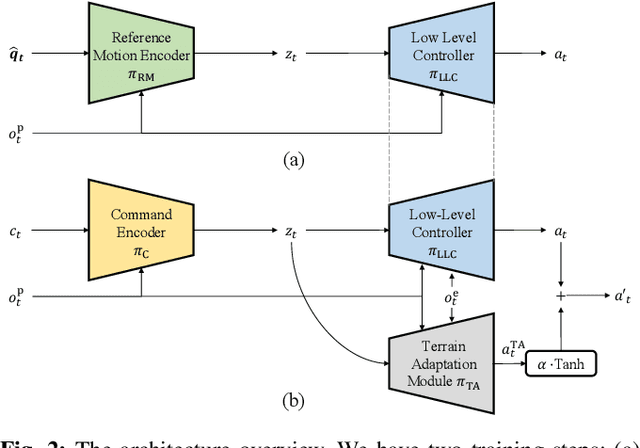
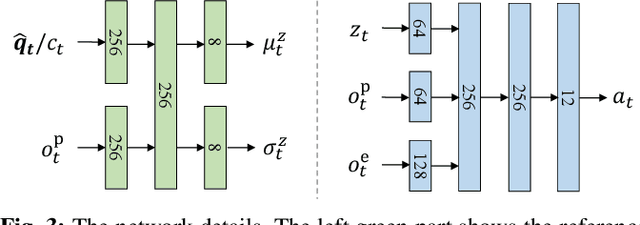
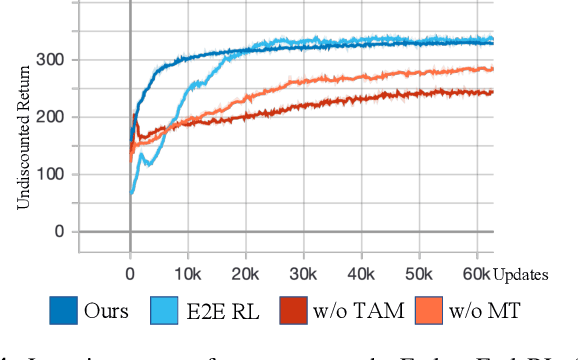
Abstract:In this paper, we present a general learning framework for controlling a quadruped robot that can mimic the behavior of real animals and traverse challenging terrains. Our method consists of two steps: an imitation learning step to learn from motions of real animals, and a terrain adaptation step to enable generalization to unseen terrains. We capture motions from a Labrador on various terrains to facilitate terrain adaptive locomotion. Our experiments demonstrate that our policy can traverse various terrains and produce a natural-looking behavior. We deployed our method on the real quadruped robot Max via zero-shot simulation-to-reality transfer, achieving a speed of 1.1 m/s on stairs climbing.
Domain Adaptation Gaze Estimation by Embedding with Prediction Consistency
Nov 15, 2020
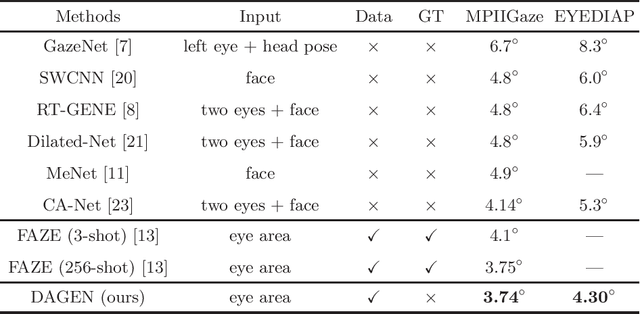
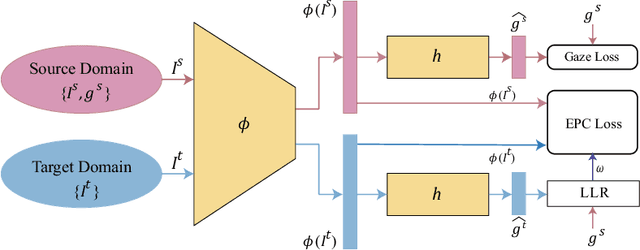

Abstract:Gaze is the essential manifestation of human attention. In recent years, a series of work has achieved high accuracy in gaze estimation. However, the inter-personal difference limits the reduction of the subject-independent gaze estimation error. This paper proposes an unsupervised method for domain adaptation gaze estimation to eliminate the impact of inter-personal diversity. In domain adaption, we design an embedding representation with prediction consistency to ensure that the linear relationship between gaze directions in different domains remains consistent on gaze space and embedding space. Specifically, we employ source gaze to form a locally linear representation in the gaze space for each target domain prediction. Then the same linear combinations are applied in the embedding space to generate hypothesis embedding for the target domain sample, remaining prediction consistency. The deviation between the target and source domain is reduced by approximating the predicted and hypothesis embedding for the target domain sample. Guided by the proposed strategy, we design Domain Adaptation Gaze Estimation Network(DAGEN), which learns embedding with prediction consistency and achieves state-of-the-art results on both the MPIIGaze and the EYEDIAP datasets.
Learning End-to-End Action Interaction by Paired-Embedding Data Augmentation
Jul 16, 2020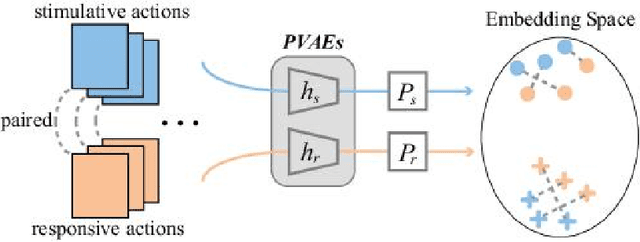

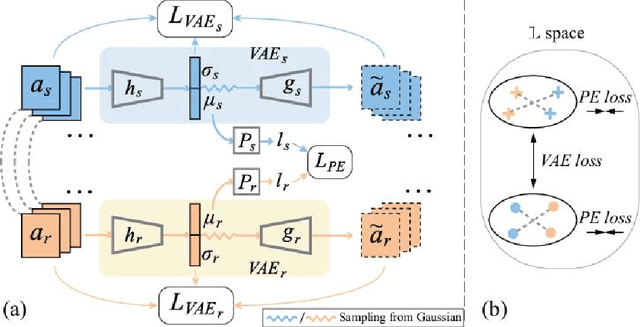

Abstract:In recognition-based action interaction, robots' responses to human actions are often pre-designed according to recognized categories and thus stiff. In this paper, we specify a new Interactive Action Translation (IAT) task which aims to learn end-to-end action interaction from unlabeled interactive pairs, removing explicit action recognition. To enable learning on small-scale data, we propose a Paired-Embedding (PE) method for effective and reliable data augmentation. Specifically, our method first utilizes paired relationships to cluster individual actions in an embedding space. Then two actions originally paired can be replaced with other actions in their respective neighborhood, assembling into new pairs. An Act2Act network based on conditional GAN follows to learn from augmented data. Besides, IAT-test and IAT-train scores are specifically proposed for evaluating methods on our task. Experimental results on two datasets show impressive effects and broad application prospects of our method.
Attention-Oriented Action Recognition for Real-Time Human-Robot Interaction
Jul 02, 2020
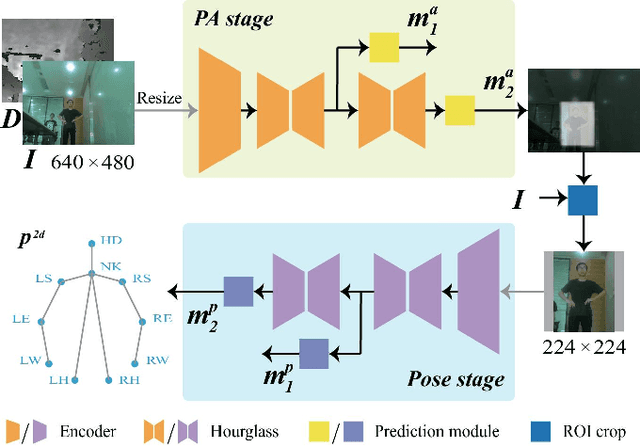
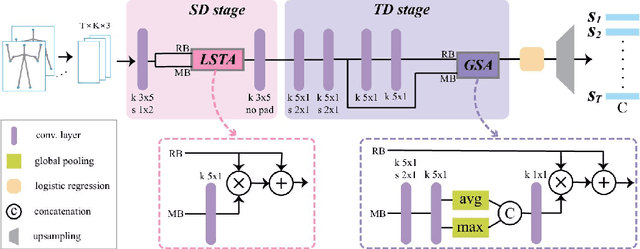
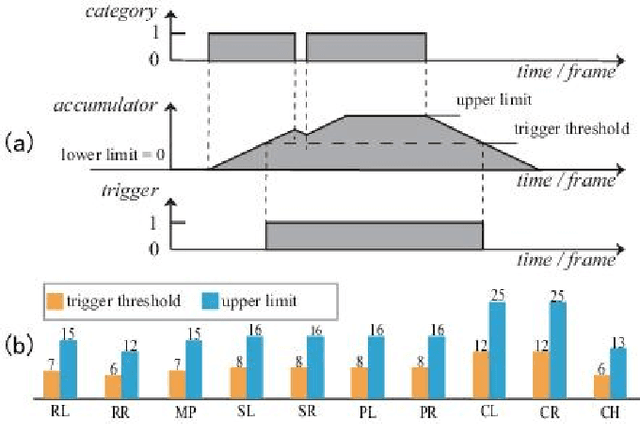
Abstract:Despite the notable progress made in action recognition tasks, not much work has been done in action recognition specifically for human-robot interaction. In this paper, we deeply explore the characteristics of the action recognition task in interaction scenarios and propose an attention-oriented multi-level network framework to meet the need for real-time interaction. Specifically, a Pre-Attention network is employed to roughly focus on the interactor in the scene at low resolution firstly and then perform fine-grained pose estimation at high resolution. The other compact CNN receives the extracted skeleton sequence as input for action recognition, utilizing attention-like mechanisms to capture local spatial-temporal patterns and global semantic information effectively. To evaluate our approach, we construct a new action dataset specially for the recognition task in interaction scenarios. Experimental results on our dataset and high efficiency (112 fps at 640 x 480 RGBD) on the mobile computing platform (Nvidia Jetson AGX Xavier) demonstrate excellent applicability of our method on action recognition in real-time human-robot interaction.
 Add to Chrome
Add to Chrome Add to Firefox
Add to Firefox Add to Edge
Add to Edge